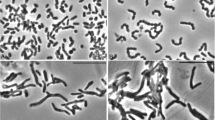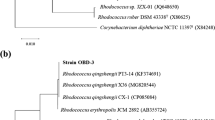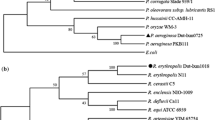Abstract
The aim of this study was to investigate oil-degrading ability of newly isolated strain Rhodococcus Y2-2 at low temperature. Rhodococcus sp. Y2-2 was isolated from oil-contaminated soil sampled at the end of winter using a newly developed transwell plate method. In the liquid phase, the oil-degradation efficiency of strain Rhodococcus sp. Y2-2 was about 84% with an initial concentration of 1500 ppm TPH (500 ppm each of kerosene, gasoline, and diesel) when incubated for 2 weeks under optimal conditions: 10 °C, pH 7, and 0.5 g L− 1 inoculum. In the soil phase, the isolate showed 80% oil degradation efficiency using glucose as a carbon source, with an initial concentration of 4000 ppm TPH and the addition of water during 14 days of incubation at 10 °C. Additionally, the degradation efficiency of the isolate was increased by the addition of mixture of surfactant alpha olefin sulfonate and gelatin, although strain Y2-2 also produced many biosurfactant components. This study shows Rhodococcus sp. Y2-2 can degrade oil components both in liquid and soil media by consuming kerosene, gasoline, and diesel as a carbon and energy source. Therefore, the crude oil-degrading ability of Rhodococcus sp. Y2-2 at low temperature provides proper bioremediation tool to clean up oil-contaminated sites especially in cold area or during winter season.
Graphical Abstract









Similar content being viewed by others
References
Aoshima H, Hirase T, Tada T, Ichimura N, Yamaguchi H, Taguchi M, Myoenzono T (2006) Improvement of heavy oil degradation by Rhodoccocus erythropolis C2. J Environ Biotechnol 5:107–109
Atlas RM (1981) Bioremediation of petroleum hydrocarbons: an environment perspective. Microbiol Rev 45:180–209
Atlas RM (1995) Bioremediation of petroleum pollutants. Int Biodeterior Biodegrad 35:317–327
Atlas RM, Bartha R (1972) Bioremediation of petroleum in seawater at low temperature. Can J Microbiol 18:1851–1855
Cheng HR, Jiang N (2006) Extremely rapid extraction of DNA from bacteria and yeasts. Biotechnol Lett 28:55–59
Felsenstein J (1985) Confidence limits on phylogenies: an approach using the bootstrap. Evolution 39:783–791
Gibbs CF, Pugh KB, Andrews AR (1975) Quantitative studies on marine biodegradation of oil. II. Effect of temperature. Proc R Soc Lond B Biol Sci 188:83–94
Gogoi BK, Dutta NN, Goswami P, Krishna MTR (2003) A case study of bioremediation of petroleum-hydrocarbon contaminated soil at a crude oil spill site. Adv Environ Res 7:767–782
Hall TA (1999) BioEdit: a user-friendly biological sequence alignment editor and analysis program for Windows 95/98/NT. Nucl Acids Symp Ser 41:95–98
Huang L, Ma T, Li D, Liang FL, Liu RL, Li GQ (2008) Optimization of nutrient component for diesel oil degradation by Rhodococcus erythropolis. Mar Pollut Bull 56:1714–1718
Jeong SW, Jeong J, Kim J (2015) Simple surface foam application enhances bioremediation of oil-contaminated soil in cold conditions. J Hazard Mater 286:164–170
Karpenko EV, Vil’danova-Martsishin RI, Shcheglova NS, Pirog TP, Voloshina IN (2006) The prospects of using bacteria of the genus Rhodococcus and microbial surfactants for the degradation of oil pollutants. Appl Biochem Mirobiol 42:156–159
Kimura M (1980) A simple method for estimating evolutionary rate of base substitutions through comparative studies of nucleotide sequences. J Mol Evol 16:111–120
Ko SH, Lebeault JM (1999) Effect of a mixed culture on co-oxidation during the degradation of saturated hydrocarbon mixture. J Appl Microbiol 82:72–79
Kretschmer A, Bock H, Wagner F (1982) Chemical and physical characterization of lipid bioflocculant produced by Rhodococcus erythropolis. Biosci Biotechnol Biochem 58:1977–1982
Kuyukina MS, Ivshina IB, Philp JC, Christofi N, Dunbar SA, Ritchkova MI (2001) Recovery of Rhodococcus biosurfactants using methyl tertiary-butyl ether extraction. J Microbiol Methods 46:149–156
Leahy JG, Colwell RR (1990) Microbial degradation of hydrocarbons in the environment. Microbiol Rev 54:305–315
Mair J, Schinner F, Margesin R (2013) A feasibility study on the bioremediation of hydrocarbon-contaminated soil from an Alpine military site: effects of temperature and biostimulation. Cold Reg Sci Technol 96:122–128
Marc A, Diane L, Gérald T, Charles WG, Françoise FG (2009) Degradation of a mixture of hydrocarbons, gasoline, and diesel oil additives by Rhodococcus aetherivorans and Rhodococcus wratislaviensis. Appl Environ Microbiol 75:7774–7782
Margesin R, Schinner F (2001) Bioremediation (natural attenuation and biostimulation) diesel-oil contaminated soil in an Alpine Glacier Skiing area. Appl Environ Microbiol 67:3127–3133
Mishra S, Jyot J, Kuhad RC, Lal B (2001a) Evaluation of inoculums addition to stimulate in situ bioremediation of oily sludge-contaminated soil. Appl Environ Microbiol 67:675–1681
Mishra S, Jyot J, Kuhad RC, Lal B (2001b) In situ bioremediation potential of an oily sludge-degrading bacterial consortium. Curr Microbiol 43:328–335
Naseri M, Barabadi A, Barabady J (2014) Bioremediation treatment of hydrocarbon-contaminated Arctic soils: influencing parameters. Environ Sci Pollut Res 21:11250–11265
Pham VHT, Kim J (2012) Cultivation of unculturable soil bacteria. Trends Biotechnol 30:475–484
Pham VHT, Jeong SW, Kim J (2014) Enhanced isolation and culture of highly efficient psychrophilic oil-degrading bacteria from oil-contaminated soils in South Korea. J Environ Biol 35:1145–1149
Ruberto LAM, Vazquez S, Lobalbo A, Mac Cormack WP (2005) Psychrotolerant hydrocarbon-degrading Rhodoccocus strains isolated from polluted Antarctic soil. Antarct Sci 17:47–56
Saitou N, Nei M (1987) The neighbour-joining method: a new method for reconstructing phylogenetic trees. Mol Biol Evol 4:406–425
Sayavedra-Soto LA, Chang WN, Lin TK, Ho CL, Liu HS (2006) Alkane utilization by Rhodococcus strain NTU-1 alone and in its natural association with Bacillus fusiformis L-1 and Ochrobactrum sp. Bitechnol Prog 22:1368–1373
Souza EC, Vessoni-Penna TH, de Souza Oliveira RP (2014) Biosurfactant-enhanced hydrocarbon bioremediation: an overview. Int Biodeterior Biodegrad 89:88–94
Svenning MM, Wartianinen I, Hestnes AG, Binnerup SJ (2003) Isolation of methane oxidising bacteria from soil by use of a soil substrate membrane system. FEMS Microbiol Ecol 44:347–354
Tamura K, Stecher G, Peterson D, Filipski A, Kumar S (2013) MEGA6: molecular evolutionary genetics analysis version 6.0. Mol Biol Evol 30:2725–2729
Thompson JD, Gibson TJ, Plewniak F, Jeanmougin F, Higgins DG (1997) The CLUSTAL_X windows interface: flexible strategies for multiple sequence alignment aided by quality analysis tools. Nucleic Acids Res 25:4876–4882
Townsend GT, Prince RC, Suflita JM (2004) Anaerobic biodegradation of alicyclic constituents of gasoline and natural gas condensate by bacteria from an anoxic aquifer. FEMS Microbiol Ecol 49:129–135
Vecchioli GI, Del Panno MT, Painceira MT (1990) Use of selected autochthonous soil bacteria to enhanced degradation of hydrocarbons in soil. Environ Pollut 67:249–258
Wang J, Wang J, Zhang Z, Li Y, Zhang B, Zhang Z, Zhang G (2016) Cold–adapted bacteria for bioremediation of crude oil-contaminated soil. J Chem Technol Biotechnol 91:2286–2297
Whyte LG, Hawari J, Zhou E, Bourbonnière L, Inniss WE, Greer CW (1998) Biodegradation of variable-chain-length alkanes at low temperatures by a Psychrotrophic Rhodococcus sp. Appl Environ Microbiol 64:2578–2584
Yoon SH, Ha SM, Kwon S, Lim J, Kim Y, Seo H, Chun J (2017) Introducing EzBioCloud: a taxonomically united database of 16S rRNA and whole genome assemblies. Int J Syst Evol Microbiol 67:1613–1617
Young CC, Lin TC, Yeh MS, Shen FT, Chang JS (2005) Identification and kinetic characteristics of an indigenous diesel-degrading Gordonia alkanivorans strain. World J Microbiol Biotechnol 21:1409–1414
Acknowledgements
This research was supported by Basic Science Research Program through the National Research Foundation of Korea (NRF) funded by the Ministry of Education (2015R1D1A1A01059664 and 2016R1D1A1A09916982).
Author information
Authors and Affiliations
Corresponding author
Ethics declarations
Conflict of interest
The authors declare that there is no conflict of interest.
Research involving with human participants
This study does not describe any experimental work related to human.
Rights and permissions
About this article
Cite this article
Van Hong Thi Pham, Chaudhary, D.K., Jeong, SW. et al. Oil-degrading properties of a psychrotolerant bacterial strain, Rhodococcus sp. Y2-2, in liquid and soil media. World J Microbiol Biotechnol 34, 33 (2018). https://doi.org/10.1007/s11274-018-2415-x
Received:
Accepted:
Published:
DOI: https://doi.org/10.1007/s11274-018-2415-x




